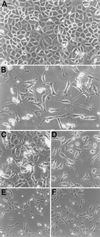Altered states: involvement of phosphorylated CagA in the induction of host cellular growth changes by Helicobacter pylori
- PMID: 10588744
- PMCID: PMC24475
- DOI: 10.1073/pnas.96.25.14559
Altered states: involvement of phosphorylated CagA in the induction of host cellular growth changes by Helicobacter pylori
Abstract
Helicobacter pylori, present in half of the world's population, is a very successful pathogen. It can survive for decades in the human stomach with few obvious consequences to the host. However, it is also the cause of gastric diseases ranging from gastritis to ulcers to gastric cancer and has been classified a type 1 carcinogen by the World Health Organization. We have previously shown that phosphorylation of a 145-kDa protein and activation of signal transduction pathways are associated with the attachment of H. pylori to gastric cells. Here we identify the 145-kDa protein as the H. pylori CagA protein. We also show that CagA is necessary to induce a growth-factor-like phenotype (hummingbird) in host gastric cells similar to that induced by hepatocyte growth factor (HGF). Additionally, we identify a second cellular phenotype induced after attachment by H. pylori, which we call SFA (stress fiber associated). SFA is CagA independent and is produced by type I and type II H. pylori.
Figures





Similar articles
-
Interaction of CagA with Crk plays an important role in Helicobacter pylori-induced loss of gastric epithelial cell adhesion.J Exp Med. 2005 Nov 7;202(9):1235-47. doi: 10.1084/jem.20051027. J Exp Med. 2005. PMID: 16275761 Free PMC article.
-
Deregulation of SHP-2 tyrosine phosphatase by the Helicobacter pylori virulence factor CagA.Keio J Med. 2002 Dec;51 Suppl 2:26-32. doi: 10.2302/kjm.51.supplement2_26. Keio J Med. 2002. PMID: 12528933
-
Focal adhesion kinase is a substrate and downstream effector of SHP-2 complexed with Helicobacter pylori CagA.Mol Cell Biol. 2006 Jan;26(1):261-76. doi: 10.1128/MCB.26.1.261-276.2006. Mol Cell Biol. 2006. PMID: 16354697 Free PMC article.
-
Helicobacter pylori CagA -- a bacterial intruder conspiring gastric carcinogenesis.Int J Cancer. 2006 Sep 15;119(6):1217-23. doi: 10.1002/ijc.21831. Int J Cancer. 2006. PMID: 16557568 Review.
-
CagA-mediated pathogenesis of Helicobacter pylori.Microb Pathog. 2016 Apr;93:44-55. doi: 10.1016/j.micpath.2016.01.005. Epub 2016 Jan 12. Microb Pathog. 2016. PMID: 26796299 Review.
Cited by
-
CagA of Helicobacter pylori interacts with and inhibits the serine-threonine kinase PRK2.Cell Microbiol. 2015 Nov;17(11):1670-82. doi: 10.1111/cmi.12464. Epub 2015 Jun 19. Cell Microbiol. 2015. PMID: 26041307 Free PMC article.
-
Bacterial phosphoproteomic analysis reveals the correlation between protein phosphorylation and bacterial pathogenicity.Genomics Proteomics Bioinformatics. 2011 Oct;9(4-5):119-27. doi: 10.1016/S1672-0229(11)60015-6. Genomics Proteomics Bioinformatics. 2011. PMID: 22196355 Free PMC article. Review.
-
Interaction with CagF is required for translocation of CagA into the host via the Helicobacter pylori type IV secretion system.Infect Immun. 2006 Jan;74(1):273-81. doi: 10.1128/IAI.74.1.273-281.2006. Infect Immun. 2006. PMID: 16368981 Free PMC article.
-
Mechanism of regulation of the Helicobacter pylori Cagβ ATPase by CagZ.Nat Commun. 2023 Jan 30;14(1):479. doi: 10.1038/s41467-023-36218-4. Nat Commun. 2023. PMID: 36717564 Free PMC article.
-
Effects of H2O2 Treatment Combined With PI3K Inhibitor and MEK Inhibitor in AGS Cells: Oxidative Stress Outcomes in a Model of Gastric Cancer.Front Oncol. 2022 Mar 16;12:860760. doi: 10.3389/fonc.2022.860760. eCollection 2022. Front Oncol. 2022. PMID: 35372019 Free PMC article.
References
Publication types
MeSH terms
Substances
Grants and funding
LinkOut - more resources
Full Text Sources
Miscellaneous

